
Obtaining Food at Sea Menu: 1 2 3 4 5 6 7 8 9 10 11 <<First
Obtaining Food at Sea During the Golden Age of Piracy, Page 11
Obtaining Food at Sea in the Late 17th and Early 18th Centuries - Catching Turtle
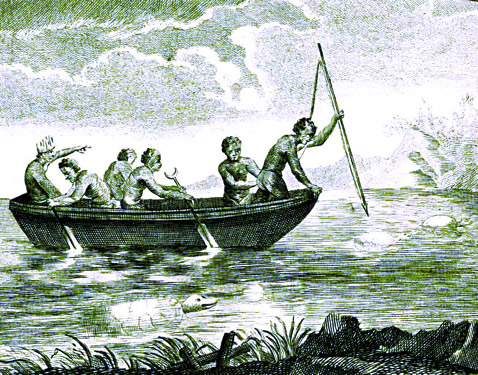
Artist: M. Chambon
Natives Hunting Turtle, Diderot's Encyclopédie, ou, Dictionnaire Raisonné des Sciences (1764)
Somewhere between hunting and fishing was the capture of turtle. Alexander Exquemelin says in his book about the exploits of Henry Morgan that the buccaneers always started their voyages by hunting for pork to salt as it was 'the most common sort' of food they ate on a voyage. However, he quickly adds that "The next [most important] food is Tortoises, which they use to salt a little."1 Exquemelin goes on to explain that this was one of the primary reasons they recruited Moskito Natives into their crew. "They are very dextrous at darting with the Javelin, whereby they are very useful to the Pirats [buccaneers], towards the victualling their Ships, by the Fishery of Tortoises, and Manita's [manatees], a sort of Fish so called by the Spaniards."2 The adeptness of the natives in catching fish, turtles and manatees was later repeated by buccaneer William Dampier who noted in 1681 that ""two Moskito Indians who always bear Arms amongst the Privateers, and are much valued by them for striking Fish, and Turtle or Tortoise, and Manatee or Sea Cow"3. (Manatee hunting is not are not included in this discussion.)
Two primary methods of catching a turtle appear in the period sailor's accounts. The first was to hunt them in the water with a spear or harpoon. Exquemelin describes 'the Spanish method' of spearing turtles which was performed "by making with a great nail a certain kind of dart.
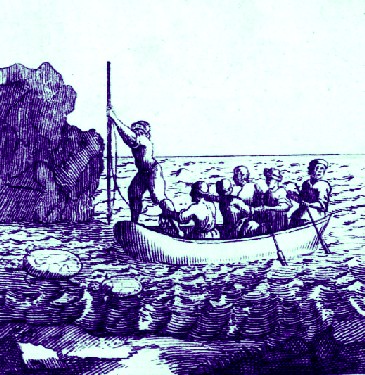
Artist: Jean-Baptiste Labat
Sailors Hunting Turtles, Nouveau voyage aux isles de l'Amerique, vol 1, (1742)
This they fix at the end of a long stick, or pole with which they wound the Tortoises, as with a dagger, whensoever they appear above water, to breath fresh air."4 Dampier explained the process as it was used by the Moskito 'Strikers' at Pulau Buton, Indonesia in 1687. He noted that since the turtles were "shy, we chose to strike them in the Night (which is customary in the West-Indies also) for every time they come up for breath, which is once in 8 or 10 Minuts, they blow so hard, that one may hear them at 30 or 40 Yards distance; by which means the Striker knows where they are, and may more easily approach them then in the Day, for the Turtle sees better than he hears"5.
While he doesn't describe the entire process of taking the turtles at sea, merchant sailor Edward Barlow explains why some could be caught at sea even as a ship was under sail in 1683. He says "we passed by a many of sea tortoises, which lying on the surface of the water, many of them courting, being upon the back of one another; one of them, being asleep, we caught, making us a very good meal for our ship’s company, being very good meat."6 Privateer George Shelvocke said that their crew would have run out of food had they not been able to spot and take turtle while they were sailing on the west coast of Mexico near Huatalco in January of 1720. "We had continual look outs for them, and they were easily known at a great distance by the sea-birds Which perch'd on their backs; so that upon sight of these we used to lay aside the advantages we might have made of the wind to embrace any offer of prolonging our provisions."7
The other primary method discussed in the sailor's accounts was to grab them on the beach
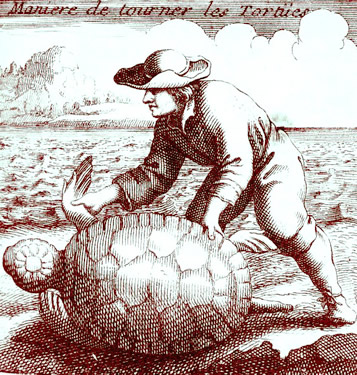
Artist: Jean-Baptiste Labat
Maniere de Tourner les Tortües, Nouveau Voyage aux isles de l'Amerique (1742)
after they had given birth. Merchant sailor Barlow described this process when he was at Ascension Island aboard the East Indiaman Delight off the coast of Africa in 1671. After "their young are hatched, they creep out of the sand presently into the sea... And the turtles, being thus 'catcht' are carried on board, and there kept alive, eating one of them every day, for one of them will serve forty or fifty men."8
Additional elements of catching turtles on land is explained by Charles Johnson in the account of pirate Thomas Anstis' time waiting for pardon at Isla de Juventud, Cuba in 1721-2. "The Manner of catching this Fish [turtle] is very particular; you must understand, that in the Months of May, June, and July, they lay their Eggs, in order to hatch their Young, and this three Times in a Season, which is always in the Sand of the Sea-shore, each laying 80 or 90 Eggs at a Time."9 While neither of these accounts explain what was done to catch the turtles, other accounts talk about 'turning' or flipping them over.10 Nathaniel Uring explains this as well as anyone in his account of the crew of the Hamilton's turtle captures while waiting for logwood to be harvested and loaded at the Bay of Campeche in July of 1712. He sent two men ashore overnight, hoping they "might take some Turtle". They "turned ten fine large Turtle, which were brought on board, on which all the Ship’s Company feasted, one being more than sufficient for all the Company for a Day."11
Although it does not appear to have been a method normally used to catch them, turtles could also be taken with nets.
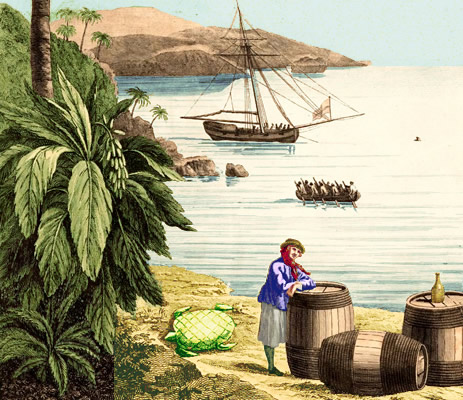
Artist: Thomas Jefferys - Turtle Taken on Caribbean Island, The West Indian Atlas (1783)
Navy sailor Clement Downing said that when HMS Salisbury was at Santiago, Cape Verde Islands in 1721, they took their net out on a boat to drag for fish. "Amongst these Fish, we found three very large Turtle, one of which was of an uncommon Size, weighing at least 400 Pound, which was looked upon, by those who had been in the West-Indies, where many of them are caught, as one of the largest that ever was taken."12
Turtle hunting was also a sport for some locals who could sell the meat to ships which stopped at their home ports. Barlow talks about this when he was aboard the West Indiaman Guannaboe at Jamaica in 1678. He explained that although the Grand Cayman Islands had
no inhabitants... the people of Jamaica come continually there to catch turtle or tortoise, which they take a-many of and carry to Port Royal, which they kill and sell by the pound for twopence and threepence per pound; and it is a thing that helps the island very much, and is very good victuals, and sometimes in the year they salt it and keep it salted a long time.13
Fellow merchant sailor Nathaniel Uring likewise mentioned that fishermen assured him that "tis very common to keep ‘em [turtles] several Weeks in the Hold of a Sloop, while they are going from the Place where they take them to Market at Jamaica"14. However, he also warned that as a result, "they waste in their Flesh, and are not near so good as when they are first taken."15
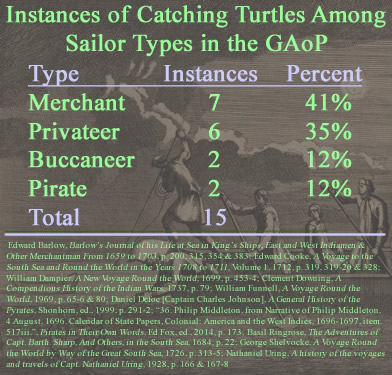
Instances of Catching Turtle by Sailor Type in the Golden Age of Piracy,
Image: Histoire des Avantiers Flibustiers, By Alexandre Exquemelin (1744)
There are 17 accounts of sailors capturing turtles for food in the accounts from the golden age of piracy. None of these concern Royal Navy sailors, most of whom were usually fed according to the prescribed diet. While the officers often had better food than the regular sailors, they probably would not have wanted turtle unless there was no other fresh meat available. Of the remaining four categories of sailors, the majority of the instances of turtle hunting took place among the merchant sailors and privateers. Note that this data only includes those instances which actually discuss sailors actively hunting turtles, not the accounts which mention them eating them. However, it is interesting that the method of turtle hunting previously discussed comes from the buccaneer account, but that they are only said to have been actively hunting them in 2 instances. Perhaps they felt that the introductory description of the process was sufficient.
Some other details of interest about turtle hunting can be found in the journey of the Woodes Rogers' privateer vessels Duke and Dutchess. when they were on the west coast of the Americas in 1709. Edward Cooke explained that when they were off of 'Cape San Francisco' (near modern Bahia de Caraquez in September of 1709, Ecuador) one of their boats came back after a night hunt bringing "13 Tortoises [which were] taken ashore, some weighing 200 l. [pounds] their Kind between a Green and a Hawks-bill". The other boat caught fifty turtles.16 Rogers' men caught several hundred more turtles over the next two days and even more of them when they sailed to the Galapagos Islands the month after. Cooke said that the turtles stayed edible for about a month and a half without being fed and "most of those we took, were Females and had round Eggs with Shells, as big as Goose-Eggs."17 This agrees with the idea that sea turtles could be easily caught on land when they came ashore to give birth.
1 Alexandre Exquemelin, Bucaniers of America, Part I, 1684, p. 85; 2 Exquemelin, p. 92; 3 William Dampier, A New Voyage Round the World, 1699, p. 1-2; 4 Exquemelin, p. 91; 5 Dampier, p. 453-4; 6 Edward Barlow, Barlow’s Journal of his Life at Sea in King’s Ships, East and West Indiamen & Other Merchantman From 1659 to 1703, p. 354; 7 George Shelvocke, A Voyage Round the World by Way of the Great South Sea, 1726, p. 314-5; 8 Barlow, p. 200; 9 Daniel Defoe [Captain Charles Johnson], A General History of the Pyrates, Manuel Shonhorn, ed., 1999, p. 291-2; See for example “36. Philip Middleton, from Narrative of Philip Middleton, 4 August, 1696. Calendar of State Papers, Colonial: America and the West Indies, 1696-1697, item. 517iii.”, Pirates in Their Own Words, Ed Fox, ed., 2014, p. 173 & Basil Ringrose, The Adventures of Capt. Barth. Sharp, And Others, in the South Sea, 1684, p. 22; 11 Nathaniel Uring, A history of the voyages and travels of Capt. Nathaniel Uring, 1928, p. 166; 12 Clement Downing, A Compendious History of the Indian Wars, 1737, p. 79; 13 Barlow, p. 315; 14 Uring, p. 167-8; 15 Uring, p. 168; 16 Edward Cooke, Voyage to the South Seas, 1712, p. 319; 17 Cooke, p. 328;
Obtaining Food at Sea in the Late 17th and Early 18th Centuries - Live Animal Pens

Shipboard Animal Pens by Sailor Type in the GAoP
Image Artist:
Marinus Adrianus Koekkoek - In the Chicken Yard (19th c.)
One solution to the problem of having fresh food available on a ship was to keep live animals which were slaughtered as needed. However, as a practical matter, animals were expensive for a ship to maintain. They required food and water and sufficient space to stay healthy and labor was required for their upkeep. All of these things were at a premium on a ship. Privateer George Shelvocke explained that when they captured a village near Diafara, Panama in January of 1721, he "went among his black cattle, and brought us what number I thought we could save, for we had but little salt, and I could not afford water to keep them alive when we came to sea; so that as soon as they were aboard, they were kill'd, and their flesh preserv'd"1.
It is likely that the high cost of maintaining animals is the reason there only 10 examples of animal pens found among the golden age of piracy sailors' accounts. The majority of these come from merchant ship accounts with the balance of them being scattered between naval, privateer and buccaneer accounts.
The only naval account is found in the Diary of Henry Teonge, the chaplain of HMS Assistance in September of 1676. The presence of the pens is only mentioned in passing as he described what happened to the ship during a storm. Teonge relates, "the morning the seas grow far more outrageous, and break clearly over our quarter-deck; driv[ing] our hen-coops overboard"2. Although he doesn't specify the reason for having the hen coop, Teonge's account tends to focus on the the actions of the officers, particularly the meals they enjoyed.
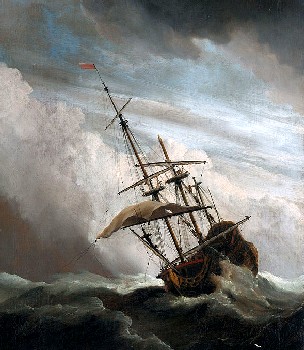
Artist: Willem van de Velde the Younger
A Ship in Need in a Raging Storm (1707)
Since the before-mast men's diet didn't include fresh meat or eggs when the ship was at sea and it would have required a large number of hens to feed the whole crew of the Assistance meat or eggs. A fourth rate navy vessel like her would have been staffed with around 300 men, so Teonge is most likely talking about hens as food for the officers. His is one of the few accounts that talks about the officer's food, which may explain why there is only this single mention of animal pens on a naval vessel.
Something else of interest in Teonge's account is that the pens were located on the open deck - otherwise they wouldn't have gotten washed overboard. Jonathan Dickinson, a passenger on the merchant barkentine Reformation, similarly reported that when their vessel wrecked, several seagulls were "by the force of the Wind blown into and under our Hen Cubs and many remained alive. Our hogs and sheep were washed away and swam on shore, except one of the hogs which remained in the vessel."3 When the East Indiaman Wentworth was caught by a storm off of Plymouth, England, Edward Barlow said it resulted in a "loss in our fresh provisions, having ‘drownded’ a hundred fowls, hens, cocks, turkeys and geese, and several pigs and hogs, and some sheep, and bruising much the live bullocks we had aboard, spoiling their flesh very much."4 All of the animals in these accounts appear to have been kept on the open deck. While aboard the merchant vessel Sarah, Henry Hunt mentions that hens were kept on the Quarter Deck.5 This is the exposed deck at the rear of the ship behind the main mast which was typically for the use of officers and their guests. This could again be taken as evidence that the hens were for the use of officers rather than the rest of the sailors.
Although Shelvocke slaughtered the cows rather than trying to keep them alive on deck while in Panama, he later noted that when they had "departed from hence the next morning, with our decks full of fowls and hogs"6. The year this, the Speedwell visited Chacao on Chiloe Island in Chili in December of 1719 to get victuals. At that time Shelvocke
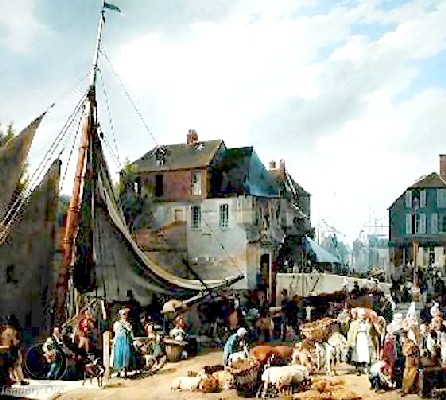
Artist: Auguste-Xavier Leprince
Loading Livestock onto the 'Passager' in the Port of Honfleur, (1823)
said, "we had now our decks full of live cattle, such as European sheep, hogs, Guanacoes [Iguana]... poultry in great abundance, and hams, &c."7 These citations do not make it entirely clear that the privateers kept the cattle on the open deck, but it seems likely based on the previous accounts.
Although there is only a few mentions of about the type of pens that animals were kept in, they would have to have been kept in an enclosed space so as not to interfere with the running of the ship.
The most often mentioned pen is the chicken coop.
Edward Teonge noted that "hen-coops" on the HMS Assistance had blown overboard, as mentioned before. Two mentions of 'hen coops' are also found in the pirates accounts, although neither concern coops kept on a pirate ship. Rather, they describe what was a board of the pirates' prey: merchant vessels. The first occurred when Edward England captured the Sarah Galley in May of 1719 at the River Gambia in Africa. In court, Henry Hunt testified that while they were in the pirates' hands, "he the Examinate ...lay every night upon the Hen Coop"8. In another testimony, this time against pirate John Gow, Robert Reid said that when the pirates boarded the George Galley at Santa Cruz de Tenerife of the Canary Islands in 1724, ship's master Oliver Fourneau "was sitting abaft upon the hencoop"9. Another account already cited mentioned that the barkentine Reformation's "Hen Cubs" were blown overboard during a storm. A search of the period dictionaries does not turn up any relevant explanation for Dickinson's use of the word cub, although it seems likely that he meant 'cube', perhaps referring to the shape of a chicken coop.
The only account from those under study which provides any detail about the enclosure of other animals comes from French priest Jean-Baptiste Labat. Returning home in 1706 after spending a decade in the West Indies, Labat sailed as a passenger on the merchant vessel St. Paul.
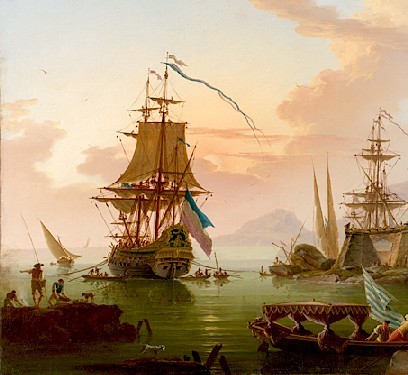
Artist: Charles-Francois de Lacroix - Arrival at a Seaport (c. 1760)
When they arrived at Cadiz, the locals swarmed the ship, attempting to sell the passengers fresh provisions. "These men were therefore surprised when they saw our pens of full of chickens, pigs, sheep and goats that there was sufficient live stock on board for a return voyage to America."10
Labat provides other insights into why live animals might be carried on a ship. He explains that another passenger,
M. Maureller, his niece and myself brought so many provisions and animals, etc., on board that we were obliged to send a quantity of poultry ashore before we sailed as there was no room for them, and it was not surprising that we had so many left when we arrived, although we frequently entertained the officers and passengers of the other ships on board our vessel during this voyage.11
As part of his passage, Labat and Monsieur Maureller were bringing animals back with them, at least in part to feed the other passengers and crew. (Labat seems to have taken particular zest in eating well.) It is possible that this was the same reason there were so many animals aboard the Reformation on which Dickinson was a passenger; he often refers to the animals as 'ours'. Working as a sailor aboard an unnamed merchant ship, Edward Coxere said that when they were at the port of 'Santa Cruz in Barbary' [Modern Agadir, Morocco], "for one piece of eight I bought above twenty hens and cocks and barley to feed them with."12 Coxere was made master of a small vessel while there, and these may have been food for the officers.
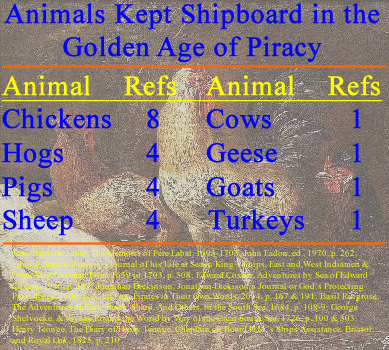
Artist: Auguste-Xavier Leprince
Loading Livestock onto the 'Passager' in the Port of Honfleur, (1823)
A wide variety of live animals have been mentioned in the accounts cited which include cows, pigs and hogs, sheep, hens, roosters, turkeys, geese and iguanas. Every account under study contains some mention of the type of livestock being kept shipboard and it is interesting to see what appear most often: the humble chicken. (They are variously referred to in these accounts as poultry, chickens, hens and cocks (roosters).) Unlike chickens, geese and turkeys are only specifically called out in a single account13, while another account is quite vague about the type of birds kept, mentioning only unspecified "fowls".14
The differentiation between hogs and pigs is also interesting. Many of the accounts mention one, but not the other. However, in Barlow's account of the storm damage to the merchant Wentworth in 1699, he says that "several pigs and hogs" were drowned. The difference is explained by Basil Ringrose in his discussion of Christmas Dinner aboard the buccaneer vessels May-flower and Trinity in 1681: "When we took the two Barks at Nicoya, we had [found] a little sucking Pigg in one of them, which we kept on Board ever since for our Christmas days Dinner which now was grown to be a large Hogg; we killed it for Dinner"15. Samuel Johnson defined 'pig' in 1756 as "A young sow or boar"16 and a 'hog' as "the general name of swine"17. So these two authors were pretty close to correct by Johnson's standard.
1 George Shelvocke, A Voyage Round the World by Way of the Great South Sea, 1726, p. 30; 2 Henry Teonge, The Diary of Henry Teonge, Chaplain on Board H.M.’s Ships Assistance, Bristol, and Royal Oak, 1675-1679, 1825, p. 210; 3 Jonathan Dickinson, Jonathan Dickinson's Journal or God's Protecting Providence (a journal of events on the Florida coast dated from 1696/7), p. 4; 4 Edward Barlow, Barlow’s Journal of his Life at Sea in King’s Ships, East and West Indiamen & Other Merchantman From 1659 to 1703, p. 508; 5 “40. Henry Hunt, from The Examination of Henry Hunt, 27 September, 1720.HCA 1/54, ff. 115-116”, Pirates in Their Own Words, Ed Fox ed., 2014, p. 191; 6 Shelvocke, p. 303; 7 Shelvocke, p. 100; 8 “40. Henry Hunt...", Pirates in Their Own Words, p. 191; 9 “35. Robert Reid, from The Examination of Robert Reid, 3 April, 1725. HCA 1/55 ff. 132-133”, Pirates in Their Own Words, p. 167; 10 Jean-Baptiste Labat, The Memoirs of Pére Labat 1693-1705, 1970, p. 262; 13 Barlow, p. 508; 14 Shelvocke, p. 303; 15 Barlow, p. 508; 16 Basil Ringrose, The Adventures of Capt. Barth. Sharp, And Others, in the South Sea, 1684, p. 108-9; 16 Samuel Johnson, A dictionary of the English language 2nd part, 1756, not paginated; 16 Johnson, A dictionary of the English language 1st part, 1755, not paginated

